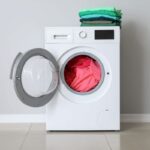You’ve washed your dishes with soap and water, but in a world full of deadly viruses and bacteria, you wonder, is it enough? How can I safely sanitize my dishes?
You can wash your dishes with bleach to sanitize them. Soak them for five minutes in a mixture of one tablespoon (15 ml) bleach to one gallon (4.54 l) of water. It’s essential to use food-grade bleach and to wash your dishes thoroughly with soap and water before soaking them in the bleach solution.
The rest of this article will address further questions on the safe use of bleach, including whether rinsing is necessary after washing dishes with bleach and if bleach is toxic after it dries.
It will also cover whether you can use bleach on plastic containers and what surfaces you should not clean with bleach.

Can You Wash Dishes With Bleach?
Bleach is an excellent way to sanitize your dishes. However, you should take necessary safety precautions when using it, as it’s a highly corrosive chemical. Bleach should never be allowed to contact your skin, and you should be careful not to breathe the fumes or get them in your eyes.
Here is a step-by-step process to help you use bleach safely to sanitize your dishes:
- Wash your dishes normally with dish soap and warm water to remove food particles and residue. If you skip this step, even bleach will not sanitize your dishes.
- Rinse the dishes thoroughly, as soap residue may react with bleach and cause toxic fumes.
- Ensure your sink (or the area where you are using bleach) is clean and clear of any other chemicals to avoid the creation of toxic fumes.
- Fill your sink with cold or room-temperature tap water. Do not use hot water! Heat impedes the sanitizing action of bleach.
- Put on rubber gloves, an apron, eye protection, and other protective clothing.
- Open windows to improve ventilation — bleach fumes irritate your respiratory system!
- Add one tablespoon (15 ml) of pure, unscented bleach for each gallon (4.54 l) of water. Mix gently.
- Add your pre-washed dishes to the bleach solution, ensuring they are fully submerged.
- Let soak for at least one minute or a maximum of five minutes.
- Drain and dry before using.
- Rinse the sink, wash your hands, and ensure bleach residue is removed from all surfaces after you’re done to avoid accidental chemical reactions later.
Do You Need To Rinse After Cleaning With Bleach?
You don’t need to rinse your dishes after sanitizing them with the bleach solution unless you have used more than the recommended amount of bleach in the bleach-to-water ratio. Your dishes should not smell of bleach after they’ve dried.
According to research done by Oklahoma State University, if you use more than one tablespoon of bleach per gallon of water, you must rinse the dishes with potable (drinkable) water before they are safe to use.
Is Bleach Toxic After Drying?
Although bleach is not technically toxic, it can be highly irritating to the respiratory tract, skin, and eyes. This is one reason you shouldn’t use it in higher concentrations than one tablespoon (15 ml) per gallon (4.54 l) of water when sanitizing your dishes.
If you have existing respiratory issues, you should take extra precautions not to breathe bleach fumes. In addition, bleach should never be ingested, as it can cause oral burns and vomiting.
A good rule of thumb is if you can smell bleach on your dishes after they have dried, they are unsafe to use. Rinse them thoroughly until the smell of bleach is gone.
Can You Use Bleach on Plastic Dishes?
You can use bleach to clean plastic dishes and food containers. However, you should use a milder solution of two teaspoons (10 ml) of bleach per gallon (4.54 l) of water. Soak for no longer than five minutes, as bleach will begin to corrode the plastic.
If your plastic dishes are old, stained, or otherwise damaged, it’s best to replace them. Using bleach may cause them to break down further and leach chemicals and microplastics into your food.
What Surfaces Should Not Be Cleaned With Bleach?
Surfaces that should not be cleaned with bleach include any porous surfaces, such as wood, marble, or granite. You should also avoid using bleach on metal and electronics. Cleaning these surfaces with bleach may cause permanent damage to them.
Don’t Use Bleach on Porous Surfaces
Never use bleach to clean porous surfaces like wood, marble, stone, granite, or anything absorbent but not launderable. Please note that many countertops are made of these materials and, thus, should never be cleaned with bleach!
If you use bleach on porous surfaces that you cannot rinse appropriately, they’ll absorb and hold onto it. This can expose you to the corrosive chemical and its fumes for a prolonged period. The bleach will also continue to break down the surface into which it’s absorbed, causing damage and discoloration.
Don’t Use Bleach on Metal
It’s not a good idea to use bleach on metallic surfaces like stainless steel because it’ll eat through the protective coating on the metal, resulting in rusting, pitting, and discoloration. Bleach will also cause erosion of other metals like copper and aluminum.
Don’t Use Bleach on Electronics
Never use bleach to clean electronics like TVs, phones, or computers. Bleach is much too harsh and will damage screens irreparably, especially touchscreen coatings like those on smartphones. Only clean and sanitize your electronics with products designed especially for them.
Cleaning Other Household Areas With Bleach Safely
You can use bleach in different concentrations to safely clean many other household surfaces, including most floors, sinks, tubs, and toilets. For detailed information on how to safely use bleach for household cleaning, sanitization, and stain removal, check out my other article on the subject.
Conclusion
To sum up, here are some things to remember about cleaning with bleach. First, always remember to pre-wash your dishes with soap and water and wear protective clothing for your safety.
Use one tablespoon (5 ml) of pure, unscented bleach to one gallon (4.54 l) of water. Then, soak the dishes for one to five minutes. Then, drain and dry them. If you can still smell bleach on your dishes, you may need to rinse them with water.
Also, never use bleach on wood, stone, granite, marble, metal, or electronics.





